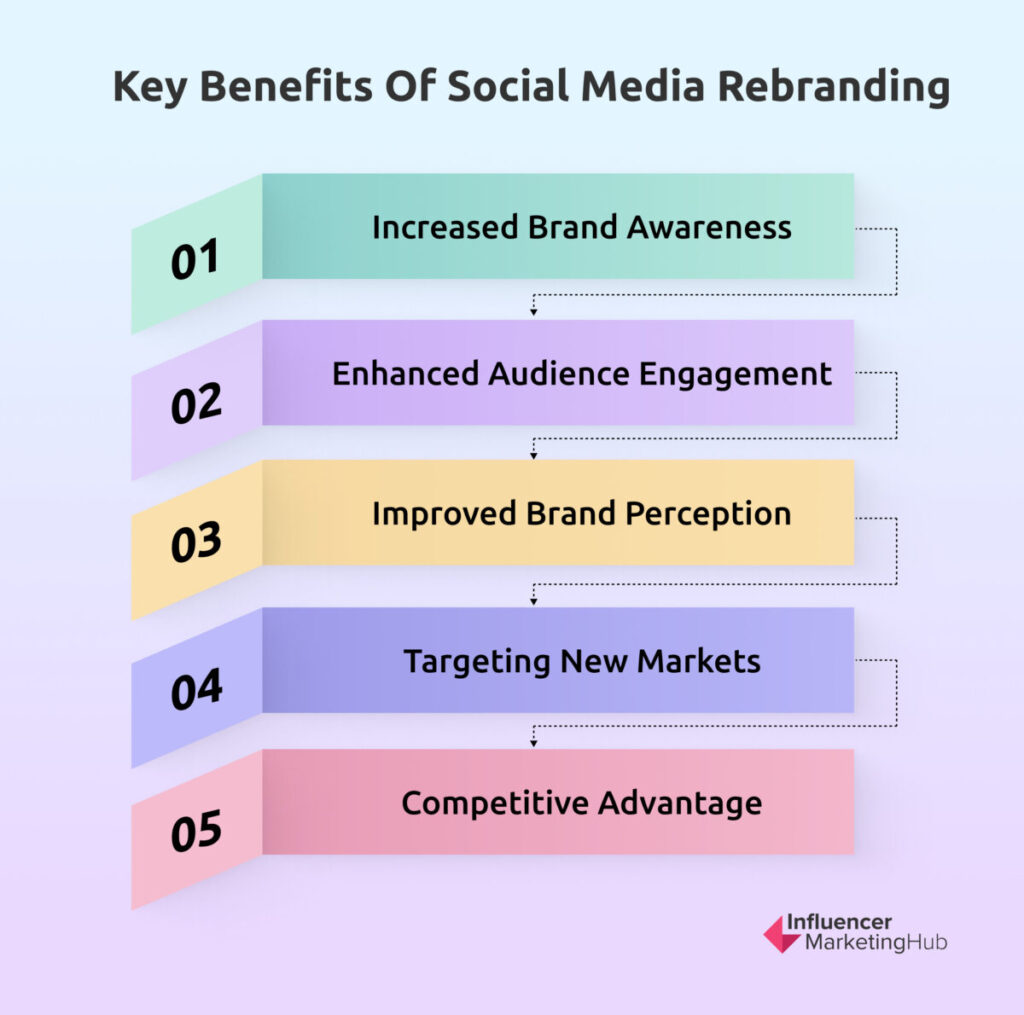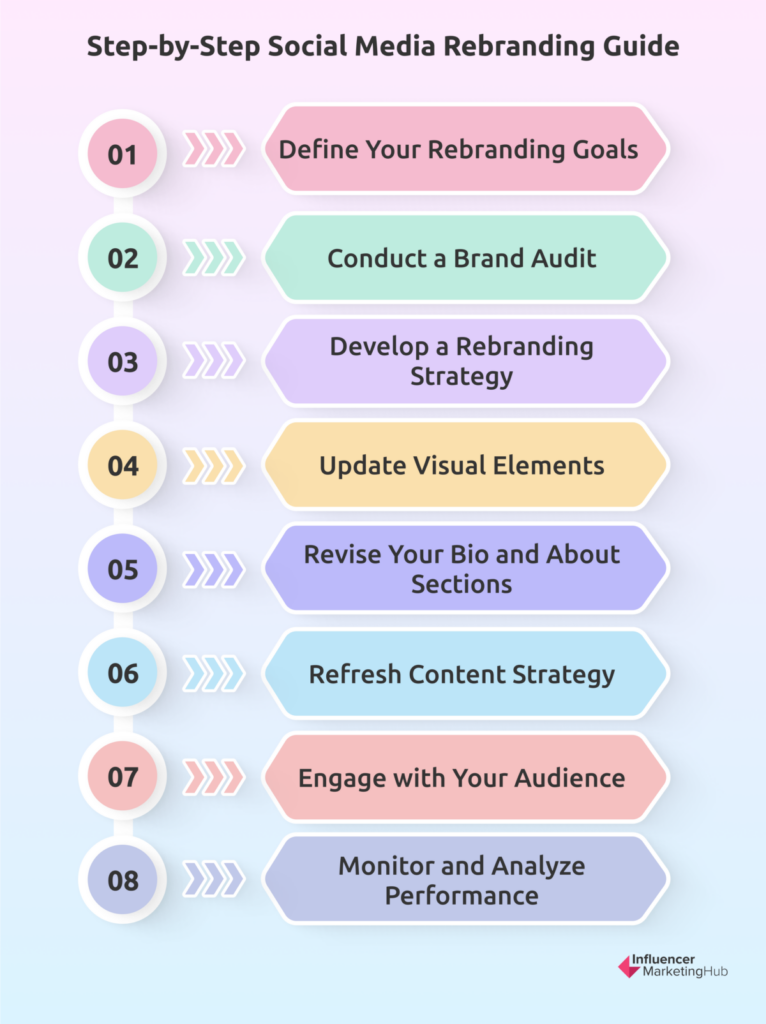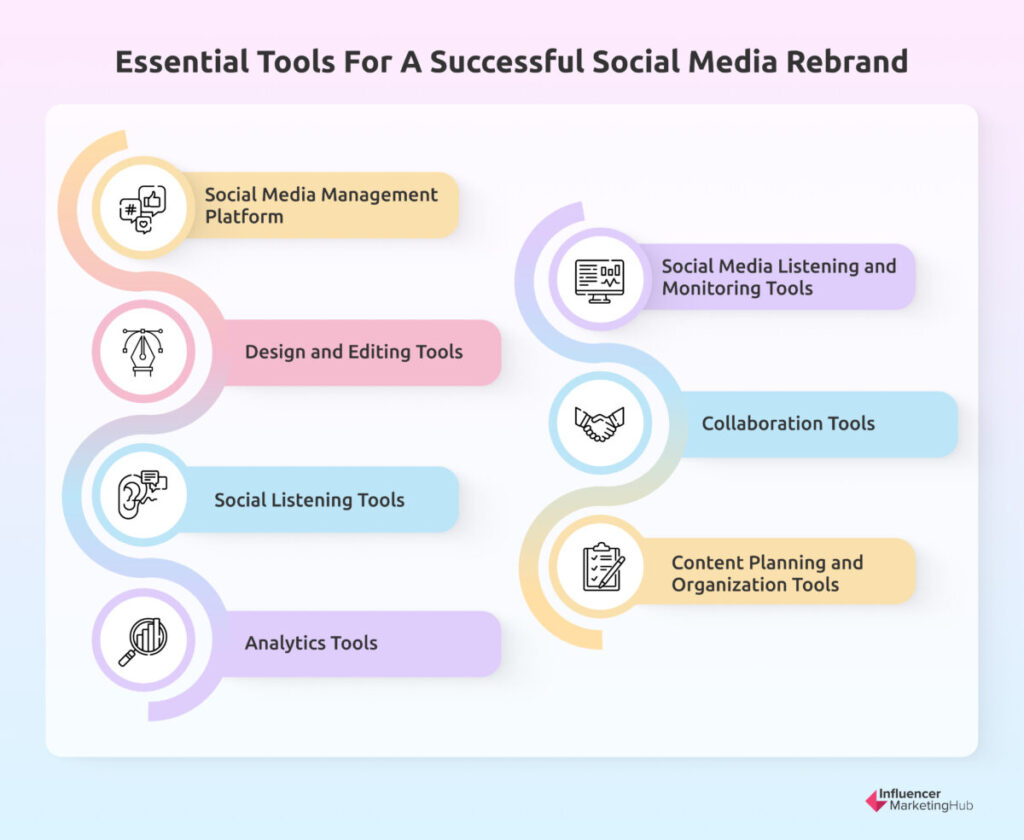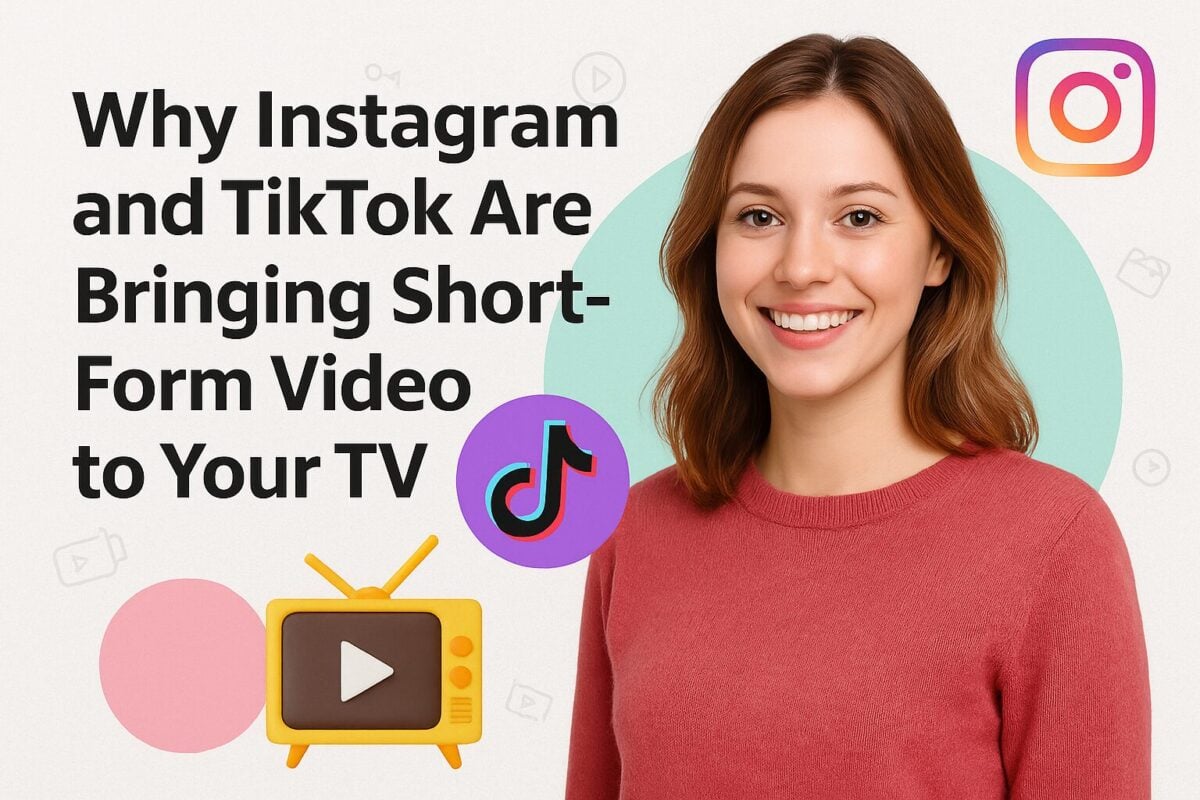Deciding to rebrand your business is a big deal and a decision to be taken lightly, especially considering that 55% of consumers are more likely to buy products if they love the brand's story. The wrong move could be detrimental to your business's image, perception, and sales.
It's tempting to jump aboard the rebrand train when you see competitors doing it. But before you make the move, assess the situation to see if it's right for your business and its target audience.
Because like they say, if it's not broken - don't fix it.
In case you find there's a need to shake things up, you'll find the following useful. Let's review what it means to rebrand across social media platforms and how you can do so effectively.
What Is A Social Media Rebrand?
A social media rebrand is the process of updating and refreshing your online presence to better align with your brand identity and goals. This involves making changes to your visual elements, messaging, and overall strategy across various social media platforms. The aim is to create a more appealing and relevant identity that resonates with your target audience, ultimately enhancing engagement and brand perception.
Rebranding may be necessary if you've transitioned your products or services, your branding has become outdated, or you've experienced changes in leadership or company values. It can also be a strategic move to reach new markets or differentiate yourself from competitors in a crowded space.
By engaging in a social media rebrand, you can increase your brand awareness, foster greater interaction with your followers, and shape a positive image in the minds of consumers. However, it's important to approach this process thoughtfully, as it requires a clear understanding of your brand identity and the ability to communicate changes transparently to your audience.
What Are The Benefits of a Social Media Rebrand?
Social media is a powerful tool for businesses and individuals to connect with their target audience. However, as trends evolve and competition intensifies, you must stay ahead by regularly assessing and updating your social media presence.
Enter social media rebranding.
Here's an overview of the key benefits of conducting a social media rebrand:
Increased Brand Awareness
A social media rebrand allows you to create a fresh and memorable identity that resonates with your target audience. For example, when Airbnb redesigned its logo and brand image, it experienced a significant increase in brand awareness and recognition, showing 86% of respondents in America are aware of the brand.

Source: DesignStudio London
Enhanced Audience Engagement
By revamping your social media presence, you can create more relevant and appealing content for your audience. This, in turn, leads to increased engagement and interaction. For instance, when Wendy's revamped its Twitter strategy and adopted a more playful and witty tone, it saw a crazy boost in revenue - $64 million in profit to be exact.
When the tweets are as broken as the ice cream machine. https://t.co/esdndK1iFm
— Wendy’s (@Wendys) November 24, 2017
Improved Brand Perception
A social media rebrand allows you to shape how your audience perceives your brand. You can establish a positive and consistent brand image by aligning your social media profiles with your brand values and messaging. As an example, when Coca-Cola rebranded its social media presence to focus on promoting sustainability and community initiatives, to improve its brand perception and positioning.
Targeting New Markets
A social media rebrand can help you reach new audiences and expand your market reach. You can tap into untapped markets by adapting your content and messaging to cater to specific demographics or geographic regions. For instance, Nike rebranded its social media strategy to target female athletes in its Dream Crazy and Dream Crazier campaigns.
Competitive Advantage
In a crowded social media landscape, a rebrand can give you a competitive edge by differentiating yourself from competitors. You can attract more followers and gain a competitive advantage by standing out with a unique and compelling social media presence. For example, Old Spice rebranded its social media strategy with humorous and viral content, poking fun at women who purchased lady-scented body wash for their men.
A successful social media rebrand can attract new followers, engage existing audiences, and create a consistent and cohesive online presence. Companies often undertake a social media rebrand to reflect changes in their business, target new markets, or improve their overall brand image.
But how can you tell whether to rebrand your social media presence?
How To Tell It's Time For A Social Media Rebrand
In the fast-paced world of social media, it's crucial to stay relevant and adapt to the changing landscape. But how do you know when it's the right time to undergo a social media rebrand? Here are some key indicators that suggest it's time for a social media makeover:
- Outdated Visuals and Design: If your social media profiles are sporting outdated logos, graphics, or visuals that no longer reflect your brand's identity or appeal to your target audience, it's a clear sign that a rebrand is in order. For example, if your logo looks pixelated or lacks a modern aesthetic, it may be time to invest in a fresh design that aligns with current design trends.
- Inconsistent Branding Across Platforms: Inconsistency in branding across different social media platforms can dilute your brand's message and confuse your audience. If your profiles have different color schemes, tone of voice, or messaging, it strongly indicates that a rebrand is needed to create a cohesive and unified brand presence.
- Declining Engagement and Reach: If you notice a decline in engagement metrics such as likes, comments, shares, or a decrease in reach and impressions, it may be a sign that your current social media strategy is not resonating with your audience. A rebrand can help you revitalize your content and regain the attention and engagement of your target audience.
- Shift in Target Audience or Market: As businesses evolve, their target audience and market may change. If you have shifted your focus to a new demographic or expanded into a different market segment, a social media rebrand can help you tailor your messaging and content to connect with your new audience effectively. For instance, if you initially target millennials but now want to reach Gen Z, a rebrand can help you adapt your social media strategy accordingly.
- Negative Brand Perception: If your brand has faced negative publicity or a reputation crisis, it might be time for a social media rebrand to rebuild trust and reshape public perception. By addressing the issues head-on and presenting a fresh and positive image, you can regain the trust and loyalty of your audience.
- Lack of Alignment with Current Industry Trends: Social media platforms and trends constantly evolve. You risk being left behind if your social media profiles are not keeping up with the latest features, functionalities, or content formats. A rebrand can help you stay current and leverage new opportunities to engage with your audience.
- Competitor Analysis: Regularly monitoring and analyzing your competitors' social media presence can provide valuable insights. If you find that your competitors have a more engaging and visually appealing social media presence, it might indicate that it's time for a rebrand to stay competitive in your industry.
Remember, a social media rebrand is not a decision to be taken lightly. It requires careful planning, research, and strategy to successfully transform. By paying attention to these indicators and recognizing when it's time for a social media rebrand, you can stay ahead of the curve and maintain a strong and impactful online presence.
How To Conduct a Rebrand Across Social Media Platforms
A social media rebrand can breathe new life into your brand and help you connect with your audience in a fresh and impactful way. However, conducting a rebrand across multiple social media platforms can be a complex process if you're not using a branding agency. To ensure a smooth and successful transition, follow these steps:
Define Your Rebranding Goals
Clearly define your rebranding goals. Identify the key objectives you want to achieve through the rebrand, such as increasing brand awareness, reaching a new target audience, or improving brand perception. This will serve as a guiding principle throughout the rebranding process.
Conduct a Brand Audit
Conduct a comprehensive brand audit across all your social media platforms before making any changes. Evaluate your current branding elements, including logos, visuals, tone of voice, and messaging. Identify any inconsistencies or areas that need improvement. This will help you understand the scope of the rebrand and what changes need to be made.
Develop a Rebranding Strategy
Create a detailed rebranding strategy that outlines the steps, timeline, and resources required for the process. Determine how you will communicate the rebrand to your audience and roll out the changes across different platforms. Consider creating a style guide or brand guidelines document to ensure consistency in visual elements, voice, and messaging.
Update Visual Elements
Update your visual elements, including profile and cover photos, headers, logos, and other visual elements representing your brand on each platform. Ensure the new visuals are consistent across all platforms and align with your rebranding goals.
Revise Your Bio and About Us Sections
Update your bio or about sections on each platform to reflect your new brand positioning and messaging. Use this opportunity to communicate your brand values, unique selling points, and any changes in your offerings or target audience. Craft compelling and concise descriptions that capture the essence of your rebrand.
Check out our Instagram Bio Ideas guide and our guide on How to Write a Professional Bio to help you with this step.
Refresh Content Strategy
Reassess your content strategy to align it with your new brand identity and goals. Determine the types of content that resonate with your audience and create a content calendar to guide your posting schedule. Consider leveraging platform-specific features and formats to enhance engagement. For example, use Stories and Reels on Instagram to showcase behind-the-scenes content or share user-generated content.
Engage with Your Audience
Maintain open communication with your audience. Announce the rebrand across your social media platforms and explain the reasons behind the change. Encourage feedback and address any concerns or questions your audience may have. Use this opportunity to build excitement and generate anticipation for the new brand.
Monitor and Analyze Performance
Monitor the performance of your branded content platforms once the rebrand is complete. Track metrics like engagement, reach, website traffic, and conversions to gauge the effectiveness of your rebranding efforts. Use this data to make informed decisions and fine-tune your social media strategy.
Remember, a social media rebranding requires ongoing effort and adaptation. Stay consistent with your new brand identity, engage with your audience, and regularly evaluate your social media performance to ensure your rebranding efforts are successful in the long run.
Tools To Use For A Successful Social Media Rebrand
A successful social media rebrand requires the right tools to streamline the process, manage content, and analyze performance. Here are some essential tools to consider and how they can benefit your social media rebrand:
Social Media Management Platform (e.g., Hootsuite, Sprout Social)
These social media scheduling tools allow you to manage and schedule your social media posts across multiple platforms from a single dashboard. They provide a centralized hub for content planning, publishing, and monitoring. Use them to schedule posts in advance, maintain a consistent posting schedule during the rebrand, and track engagement metrics.
Design and Editing Tools (e.g., Canva, Adobe Creative Cloud)
Design and editing tools help you create visually appealing graphics, edit images, and customize templates for your social media posts. These tools are particularly useful during a rebrand as they allow you to update your visual elements, create new branding assets, and maintain a cohesive and professional look across all platforms.
Social Listening Tools (e.g., Brandwatch, Mention)
Social listening tools enable you to monitor conversations and mentions of your brand across social media platforms. They provide valuable insights into audience sentiment, industry trends, and competitor activity. Use these tools during a rebrand to gather feedback, track brand perception, and identify opportunities for engagement and improvement.
Analytics Tools (e.g., Google Analytics, Facebook Insights)
Analytics tools track and measure the performance of your social media campaigns. They provide data on audience demographics, engagement metrics, website traffic, and conversions. Use these tools to assess the impact of your rebranding efforts, identify areas for improvement, and make data-driven decisions to optimize your social media strategy.
Social Media Listening and Monitoring Tools (e.g., Sprout Social, Hootsuite Insights)
These tools allow you to monitor and analyze social media conversations, trends, and mentions in real time. Use them to stay informed about industry trends, track brand mentions, and identify opportunities for engagement during your rebrand. Monitor keywords related to your rebrand to gauge audience sentiment and adjust your strategy accordingly.
Collaboration Tools (e.g., Trello, Asana)
Collaboration tools streamline communication and project management during a social media rebrand. They enable teams to collaborate, assign tasks, and track progress in a centralized platform. Use these tools to coordinate efforts, ensure everyone is aligned with the rebranding strategy, and meet deadlines effectively.
Content Planning and Organization Tools (e.g., ContentCal, CoSchedule)
Content planning and organization tools streamline your content creation process and maintain a consistent posting schedule. Use these tools to plan and visualize your content calendar, collaborate with team members, and ensure a smooth transition during the rebrand. Plan your content, considering the specific messaging and visuals associated with your rebrand.
Tips For Using These Tools For A Social Media Rebrand
Wait - before you start building your social media rebrand tech stack, keep the following tips in mind:
- Integrate your social media management platform with your other tools to streamline workflows and ensure a seamless transition during the rebrand.
- Leverage design and editing tools to create visually appealing graphics that reflect your new brand identity and messaging.
- Regularly monitor and analyze social media metrics using analytics tools to track the impact of your rebranding efforts and make data-driven decisions.
- Use social listening and monitoring tools to stay informed about industry trends, track brand mentions, and engage with your audience during the rebrand.
- Collaborate effectively using collaboration tools to ensure all team members are aligned with the rebranding strategy and tasks are completed on time.
- Use content planning and organization tools to maintain a consistent posting schedule and plan your content in advance, incorporating the specific messaging and visuals associated with your rebrand.
By leveraging these tools effectively, you can streamline your social media rebranding process, enhance collaboration, and measure the success of your efforts.
Examples of Rebranding Across Social Media
So what are some examples of companies that rebranded their companies and social media profiles? Let's take a look.
1. Mailchimp...With A Lower Case c
Mailchimp began as an email marketing company but has become a prominent marketing platform for small businesses. It helps millions of customers worldwide grow their businesses, not just using emails, but by offering a full suite of marketing tools and services.
It even changed its name from “MailChimp” to “Mailchimp” with a lowercase c in 2018.

Source: mailchimp.com
And here's a glimpse of how Mailchimp evolved its logos and branding over the years.
2. Pringles Gets A Haircut
For decades, Pringles potato chips had a Monopoly-esque mascot with a curly mustache and and bow tie. Today, the logos changed to exclude the hair and turned the Pringles into the bow tie (nice touch, btw).
Pringles has revealed a rebrand: https://t.co/gDWhURT3ut pic.twitter.com/MaXrdeIFuX
— Design Week (@Design_Week) September 22, 2021
But that's not all - its designers went as far as to create over a dozen versions of the new face that can easily be used as emojis on social media.
3. Gumroad and Discord Announce Their Transition On Social
Using your social channels to promote your rebranding should be a no-brainer. After all, you want your audience to recognize you after the makeover.
Here's how Gumroad handled it on Twitter:
A new Gumroad is coming.
See you on Black Friday. pic.twitter.com/YwmhMso1YU
— Gumroad (@gumroad) November 22, 2021
Do the same by sharing updates about the rebranding process and responding to comments and answering questions from your audience.
And then here's another example from Discord, which spells out what its audience can expect from the company's rebrand:
hey
we're updating our brand look. improved logo, font, colors. not too different: just a little friendlier.
Discord has become a place where people come to explore, grow, and belong. so we're updating our look to be just as welcoming: https://t.co/OedvENyboE pic.twitter.com/LyqCx9EyEH
— Discord (@discord) May 13, 2021
4. Dunkin' Donuts Switches To A First-Name Basis
Many of us grew up with Dunkin' Donuts (who else has had the Dunkin' Donuts vs. Krispy Kreme debate as a child?). But after years of using Dunkin' as a moniker, the brand decided to leave behind "Donuts" and simply go by its first name: Dunkin'.
Makes sense, since its tagline has been used for years - "America runs on Dunkin'."
Once it became official, Dunkin' spread the news across social media:
It’s official: We’re going by Dunkin’ now. ? After 68 years of America running on Dunkin’, we're moving to a first-name basis. ? Excited to be #BFFstatus with you all ?☕️? #firstnamebasis #besties pic.twitter.com/hmzd2Bamlm
— Dunkin' (@dunkindonuts) September 25, 2018
Craft A Stronger Brand Identity With A Social Media Rebrand
Do you feel like your company no longer attracts the right audience? Then maybe it's time to revisit your brand's identity. A new logo, tagline, or shift in marketing approach could all help to reposition your business as the go-to for your target customers.
Whatever you decide to do, keep your audience involved by interviewing and surveying them to learn their views so you can get your next rebrand right.
Frequently Asked Questions
What is social media rebranding?
Social media rebranding involves updating your brand's identity, messaging, and visual elements across social media platforms to create a fresh and memorable presence that resonates with your target audience.
Why should a business consider rebranding on social media?
Businesses may rebrand on social media to increase brand awareness, enhance audience engagement, improve brand perception, target new markets, and gain a competitive advantage in a crowded landscape.
How can I tell if it's time to rebrand my social media presence?
Signs that indicate a need for rebranding include outdated visuals, inconsistent branding across platforms, declining engagement metrics, shifts in target audience, negative brand perception, and lack of alignment with current industry trends.
What are the first steps in developing a rebranding strategy?
The initial steps include defining clear objectives and vision, conducting thorough market research, involving your team in the process, and creating a comprehensive rebranding strategy that outlines key changes.
How important is consistency in branding across different platforms?
Consistency is crucial as it helps to reinforce your brand's message and identity. Inconsistent branding can confuse your audience and dilute your brand's impact.
How can I measure the success of my rebranding efforts?
Success can be measured through various metrics, including changes in customer engagement, brand sentiment, reach, and sales performance. Regular evaluation of these metrics will help assess the effectiveness of the rebranding.
What are some common pitfalls to avoid during a rebrand?
Common pitfalls include neglecting market research, failing to involve employees, inconsistent messaging, and not monitoring audience reactions post-launch. These can lead to backlash or failure to achieve rebranding goals.
What are some successful examples of social media rebranding?
Notable examples include Airbnb's logo redesign, Wendy's playful Twitter strategy, and Coca-Cola's focus on sustainability, all of which led to increased brand awareness and engagement.






